The exact origins of floristry are shrouded in time, but evidence suggests the profession has roots in ancient civilizations. Egyptians cultivated flowers for religious ceremonies and funerary practices, while the Greeks and Romans used them for decoration and medicinal purposes. During these early periods, the role of flower sellers likely overlapped with that of herbalists, who possessed knowledge of the botanical properties of plants.
The Middle Ages witnessed a renewed interest in flowers, particularly in Europe. Monasteries became centers for cultivating flowers for religious festivals and medicinal use. Symbolic meanings were attached to various blooms, with lilies representing purity and roses signifying love and passion. By the 17th century, the Dutch Golden Age saw a flourishing of floral culture. Tulips became a prized commodity, and skilled flower arrangers emerged, catering to the wealthy elite.
The 18th and 19th Centuries: A Golden Age for Florists
The 18th and 19th centuries witnessed a remarkable transformation in the world of floristry. Advances in greenhouse technology paved the way for cultivating a broader array of blooms, making flowers more accessible. This, coupled with the Victorian era’s intense fascination with floral symbolism, fueled a surge in demand for floral arrangements, transforming florists into skilled artisans of expression.
Flowers became inextricably woven into the fabric of Victorian society. Homes were adorned with elaborate bouquets, each bloom thoughtfully chosen to convey a particular sentiment. “The flowers chosen and the way these were presented…could speak volumes,” observes a historical source. This complex “language of flowers” allowed for the articulation of social status, emotions, and unspoken messages within a rigid societal structure. The popularity of flower dictionaries during this time underscores the public’s desire to understand this intricate floral code.
The insatiable desire for meaningful floral displays elevated the florist’s role. Once considered simple flower sellers, florists honed their skills in design, becoming masters of symbolic communication through their creations. Weddings transformed into fragrant spectacles with each floral choice holding significance, while funerals incorporated somber tones in their arrangements. From celebrations to condolences, florists crafted visual stories that resonated with the occasions and the deep emotions attached to them.
The 20th century brought significant changes to the florist industry. The development of commercial greenhouses and improved transportation facilitated the mass production and distribution of flowers. This led to a decline in the price of blooms, making them more accessible to the general public. Marketing also played a crucial role in shaping consumer demand. The establishment of national holidays like Mother’s Day and Valentine’s Day, coupled with strategic marketing campaigns by flower growers and retailers, encouraged the association of flowers with specific occasions and gift-giving traditions.
The 21st Century: A Diverse and Evolving Landscape
The world of floristry in the 21st century is a dynamic and multifaceted landscape. Digital technologies are redefining the customer experience, while greater environmental awareness and a desire for individuality are influencing trends within the floral industry. The modern florist embraces both technological innovation and thoughtful, personalized approaches, catering to the evolving needs and preferences of contemporary consumers.
The digital revolution has significantly impacted the florist industry. Online flower ordering platforms and direct-to-consumer services provide unparalleled convenience for customers, allowing them to browse, compare, and purchase floral arrangements from the comfort of their homes. “With a few clicks, customers can send a stunning bouquet across town or the country,” notes a florist industry expert. This enhanced accessibility to flowers caters to the busy lifestyles and on-demand expectations of modern consumers.
Alongside technological advances, a growing emphasis on sustainability has emerged. Increasingly, florists are prioritizing eco-conscious practices. This includes sourcing flowers from local growers to reduce transportation-related carbon footprints, offering compostable packaging options, and minimizing water waste. Environmentally conscious consumers are drawn to florists who demonstrate a commitment to sustainable practices, aligning their floral choices with their values.
The 21st century has also witnessed a shift towards personalized, bespoke floral arrangements. Customers seek unique and expressive creations that reflect their individual tastes or the specific sentiments of an occasion. Florists are adapting to this trend by offering customized designs, incorporating unusual blooms, and embracing a wider range of textures and styles. The modern floral experience prioritizes creativity and collaboration, empowering customers to co-create memorable floral expressions.













